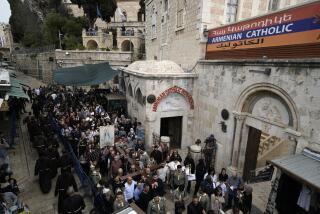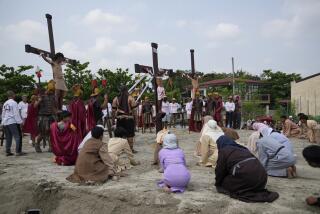Possible Path of Jesus Is Cleared
- Share via
JERUSALEM — Israeli archeologists have cleared part of the path they say they believe was taken by Jesus as he entered this city not long before his crucifixion.
They have dug through nearly two millenniums of rubble and construction to reveal a path of broad white stone tiles, passing under what was then a colossal arch at the foot of the Jewish Temple’s towering outer walls.
“For the first time in the archeology of Jerusalem, we have exposed a large part of the network of roads built by Herod around the Temple Mount,” said Gideon Avni, chief archeologist of Jerusalem.
When Jesus came to Jerusalem, he “came from the Mount of Olives, probably stepping on this pathway,” Avni said.
The excavation done in the past four years extends various projects undertaken since 1869, digging through many layers of Jerusalem’s Old City adjacent to the Western Wall revered by Jews and at the base of the Islamic Al Aqsa mosque.
Archeologists have excavated levels that reveal three of the many periods of Jerusalem’s rich history. They have exposed streets used during the Jewish period under King Herod, a broad street and several homes that existed during the Christian Byzantine period that started in the 4th century, and parts of four Islamic palaces erected after Arabs conquered the city in AD 638.
Jerusalem’s archeological history is particularly difficult to sort out because so many peoples built on top of the buildings of the previous group, often using the same stones. The Herodian street of Jesus’ time has been known to archeologists for a century, but architects now have cleared about 70 yards of the avenue to show what it was like at the time.
“I have a sense of responsibility to the public to leave not just dry reports that 10 people in the world will read, but the site so people can learn about it,” said Ronny Reich, who directed the excavations.
The work also exposed several narrow shops built of stone, which were part of what would have been a busy commercial avenue outside the temple. They found bronze coins and weights that might have been used to measure meat or yarn, Reich said.
The most dramatic sight of the find is a pile of huge stones at one end of the street, uncovered where they fell 160 feet onto the street when Roman soldiers methodically destroyed the Jewish Temple and the walls surrounding it in AD 70.
Israel is opening the excavated areas to the public. What it calls the Archeological Park will open fully by 2000. Much of it is already accessible to tourists, although there are no explanatory signs.
“We think this area will be a focus of tourism,” Avni said. “We wanted to take one of the most ancient parts of the city, and one of the most neglected, and make it into a sort of guidebook for tourists” by revealing different periods in the city’s history.
“This is the only area where the visitor can actually walk on the streets of the Jerusalem of Jesus Christ’s time,” said Avni.
Sort of. The Rev. Jerome Murphy-O’Connor, a professor of the New Testament and author of “The Holy Land,” says the stone tiles were replaced or added about 30 years after Jesus was crucified.
King Herod Agrippa II was left with an idle work force of about 18,000 men when the temple was completed, and he created an ambitious public works project to employ them. Part of their job was to place new stones on the streets.
The new archeological park will give tourism in the Old City a more historically accurate footing than many myths that now batter pilgrims. For example, the trek taken by thousands of visitors annually along the “Stations of the Cross” and the Via Dolorosa has no basis as the actual route of Jesus. The city was not built up near that level, and historical evidence indicates that Jesus went in a different direction, Murphy-O’Connor says.
Christian pilgrims who began following a prayer route of Franciscan monks along that route “were more interested in piety than in history,” he said. But now, the route “is sanctified by tradition. And you do get the same experience [as Jesus] of walking in a narrow street being jostled around by the crowd.”
The Israeli excavation by what is called the Dung Gate has opened up an area that was certainly seen by Jesus, Murphy-O’Connor says.
“It doesn’t need a great imagination to re-create that scene and populate it,” he said.
Avni said the excavation project is an attempt to be fair to the three major religions that have occupied Jerusalem. All sides criticized the work--at one point, work stopped for six months because religious Jews challenged the moving of building blocks that had been used by Jews and Muslims.
Avni said he believes that the archeologists convinced most critics that the work is objective and apolitical. But he conceded: “Nothing is disconnected from politics here. This isn’t only archeology. You have for everyone some corner of their own identity.”
More to Read
Sign up for Essential California
The most important California stories and recommendations in your inbox every morning.
You may occasionally receive promotional content from the Los Angeles Times.










